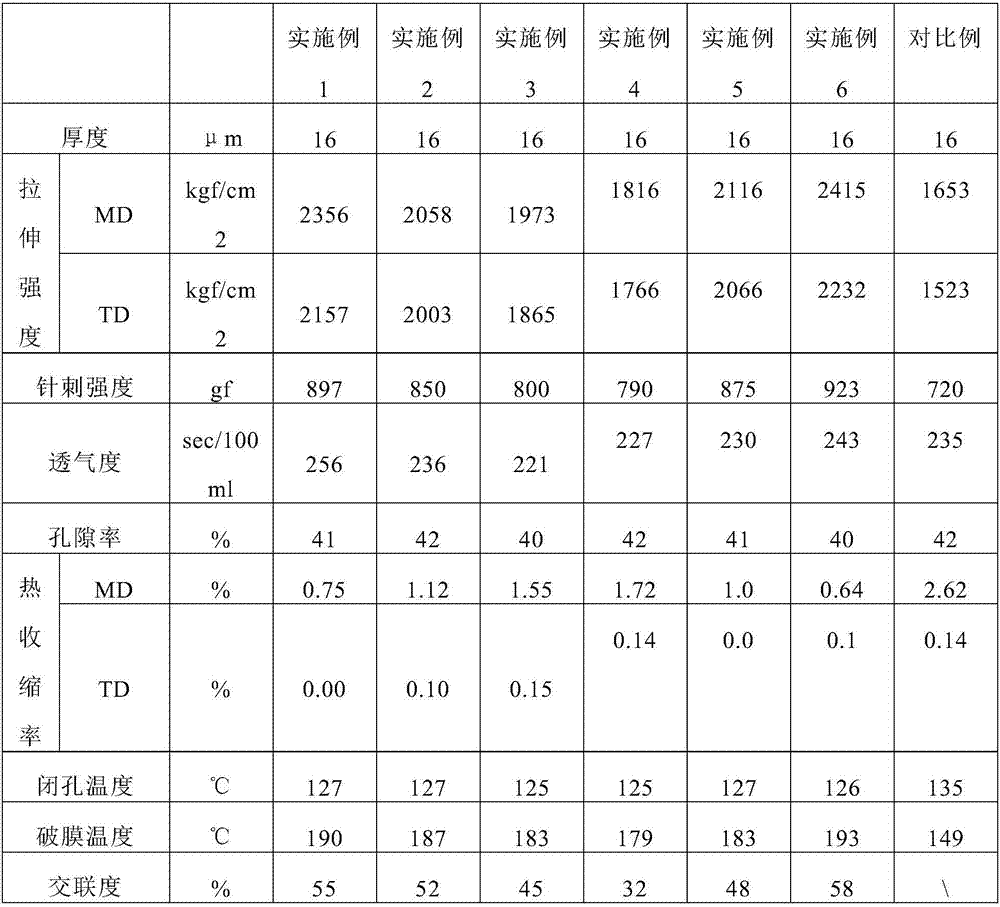Preparation method for isolating membrane of lithium ion battery
A lithium-ion battery and separator technology, applied in the field of electrochemistry, can solve the problems of complex process and high cost
- Summary
- Abstract
- Description
- Claims
- Application Information
AI Technical Summary
Problems solved by technology
Method used
Image
Examples
preparation example Construction
[0031] The preparation method of lithium-ion battery separator provided by the invention comprises steps:
[0032] The first step is to prepare cross-linkable polyethylene;
[0033] The second step is twin-screw extrusion to obtain a liquid-phase stable system;
[0034] In the third step, the cast sheet is cooled and formed;
[0035] The fourth step is stretching into a film;
[0036] The fifth step, extraction and polycondensation cross-linking;
[0037] The sixth step, the aging process.
[0038] The preparation method provided by the present invention selects polyethylene material as the base resin, completes the silane grafting reaction through a twin-screw extruder, thereby obtaining cross-linkable polyethylene, and then mixes it with a high boiling point, low molecular weight small molecule filler to form a thermodynamic The single-phase polymer solution, through cooling, the solution phase separation occurs, and the polymer solidifies into a thick sheet at the same ...
Embodiment 1
[0074] Use high-density polyethylene (HDPE, Mw=5*10 5 , melting point 124°C) as polyethylene raw material, 100 parts by weight of HDPE, 2 parts by weight of vinyltrimethoxysilane, 0.075 parts by weight of dicumyl peroxide and 0.0125 parts by weight of dibutyltin dilauric acid were mixed evenly, after precise The metering system is added to the twin-screw extruder to obtain silane-grafted polyethylene. The temperature of each section of the extruder is 140°C-180°C-200°C-210°C-200°C.
[0075] Using the silane cross-linked polyethylene prepared above as component I, the kinematic viscosity at 100°C is (7-8)mm 2 / s paraffin oil as component II. The contents of component I and component II are 30% by weight and 70% by weight respectively. The polyethylene solution is formed by melting and mixing through a twin-screw extruder (φ=30mm). The extrusion temperature is 150-250 degrees Celsius and the rotation speed is 200 rpm. The obtained solution is extruded from the die head throug...
Embodiment 2
[0077] Use high-density polyethylene (HDPE, Mw=5*10 5 , melting point 124°C) as polyethylene raw material, 100 parts by weight of HDPE, 1 part by weight of vinyltrimethoxysilane, 0.075 parts by weight of dicumyl peroxide and 0.0125 parts by weight of dibutyltin dilauric acid were mixed evenly, after accurate The metering system is added to the twin-screw extruder to obtain silane-grafted polyethylene. The temperature of each section of the extruder is 140°C-180°C-200°C-210°C-200°C.
[0078] Using the silane cross-linked polyethylene prepared above as component I, the kinematic viscosity at 100°C is (7-8)mm 2 / s paraffin oil as component II. The contents of component I and component II are 30% by weight and 70% by weight respectively. The polyethylene solution is formed by melting and mixing through a twin-screw extruder (φ=30mm). The extrusion temperature is 150-250 degrees Celsius and the rotation speed is 200 rpm. The obtained solution is extruded from the die head throug...
PUM
| Property | Measurement | Unit |
|---|---|---|
| boiling point | aaaaa | aaaaa |
| density | aaaaa | aaaaa |
| strength | aaaaa | aaaaa |
Abstract
Description
Claims
Application Information
 Login to View More
Login to View More - R&D
- Intellectual Property
- Life Sciences
- Materials
- Tech Scout
- Unparalleled Data Quality
- Higher Quality Content
- 60% Fewer Hallucinations
Browse by: Latest US Patents, China's latest patents, Technical Efficacy Thesaurus, Application Domain, Technology Topic, Popular Technical Reports.
© 2025 PatSnap. All rights reserved.Legal|Privacy policy|Modern Slavery Act Transparency Statement|Sitemap|About US| Contact US: help@patsnap.com

